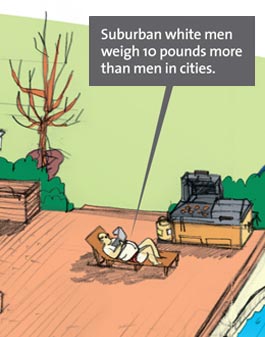
Illustration by: <a href="http://www.foxnathan.com/" target="new">Nathan Fox</a>
To view this article with Nathan Fox‘s illustration, as it appeared in the March/April 2005 issue of Mother Jones magazine, download the following PDFs:
MJ026.pdf (7.6 MB)
MJ027.pdf (8.4 MB)
- Since 1950, the average new house has increased by 1,247 sq. ft. Meanwhile, the average household has shrunk by 1 person.
- The National Association of Home Builders’ “showcase home” for 2005 is 5,950 sq. ft. That’s 15% bigger than last year’s model.
- The Unabomber’s legal defense team cited the size of his shack—10’ x 12’—to buttress his insanity plea.
- 1 in 4 Americans want at least a 3-car garage.
- 88% of American commuters drive to work.
- 76% of those drivers commute alone.
- The number of Americans with commutes of longer than 90 minutes each way has increased 95% since 1990.
- Since 1982, 35 million acres—an area the equivalent of New York state—have been developed.
- More than 50% of exurban lots are 10 acres or larger. Exurban homes account for 80% of residential development since 1994.
- In 1950, 1 in 100 homes had 2.5 baths or more. Today, 1 in 2 do.
- 14 million households own 4 or more TVs.
- Americans spend more to power home audio and video equipment that is “off” but still plugged in than they do to power such devices while actually in use.
- Such “energy vampires” consume 5% of the nation’s electricity.
- Extreme Makeover: Home Edition recently gave a 6-bedroom, 7-bath, 7-television house to a family of 4.
- Americans with cable TV have 30 hours of home-improvement programming available to them each day.
- Sales of Sub-Zero and other “premium” and “superpremium” refrigerators have been rising by 15% a year.
- 1 in 5 new homes is larger than 3,000 sq. ft.—the size at which it becomes unmanageable to clean without hired help.
- The average cost of a luxury kitchen remodel is $57,000. That’s $10,000 more than it costs to build a typical Habitat for Humanity home.
- Suburban and urban kids use illegal drugs, have sex, fight, and steal at the same rates, but suburban kids are more likely to drink and smoke.
- 0.03% of U.S. homes are fueled by solar energy. 0.4% lack complete plumbing facilities.
- People who live in cities use half as much energy as suburbanites.
- If Americans bought only appliances with an“Energy
Star” rating over the next 15 years, the reduction in greenhouse gases would equate to taking 17 million cars off the road. - 1/3 of a home’s heating oil is used for hot water. Multiple-head shower systems can drain a 40-gallon tank in less than 4 minutes.
- The average new home requires 13,837 board feet of lumber and 19 tons of cement.
- Since 1976, federal housing assistance has been slashed by 48%.
- Last spring, the Bush administration proposed an additional $1 billion cut to the Section 8 housing subsidy.
- 87% of homeowners are white.
- Overall, blacks receive subprime loans 2.83 times more often than whites. The disparity increases when affluent blacks are compared to affluent whites.
- If it were a state, New York City would rank 51st in energy use per capita.
- Suburban white men weigh 10 pounds more than men in cities.
- Only 2.7% of San Francisco’s teachers, 5.7% of its cops, and 4.2% of its nurses can afford to buy a home there.
- 1 in 4 Californians are considering moving out of state to reduce their housing costs.
- Rush Limbaugh’s Palm Beach estate is worth 15 times the value of Bill and Hillary Clinton’s Chappaqua, N.Y., home.
- 7% of all homes are in gated communities.
- 7% of all homes are mobile homes.
- Since 2001, the number of Americans who have bought
second homes has increased by 24%.











